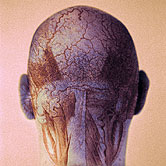- Skip Storing This Everyday Product in the Fridge Door
- Green Tea + B3 Pairing May Boost Brain Health
- Navigating Your Midlife Crisis: Embracing New Possibilities
- City Raccoons Showing Signs of Domestication
- Mapping the Exposome: Science Broadens Focus to Environmental Disease Triggers
- One Week Less on Social Media Linked to Better Mental Health
- Your Brain Changes in Stages as You Age, Study Finds
- Some Suicide Victims Show No Typical Warning Signs, Study Finds
- ByHeart Formula Faces Lawsuits After Babies Sickened With Botulism
- Switch to Vegan Diet Could Cut Your Greenhouse Gas Emissions in Half
Controversial Treatment May Not Help MS Patients


TUESDAY, Oct. 8A theory claiming that multiple sclerosis (MS) is caused by the narrowing of veins in the neck appears to be unfounded, Canadian researchers report.
Called “chronic cerebrospinal venous insufficiency” (CCSVI), Dr. Paolo Zamboni, from the University of Ferrara, in Italy, first proposed the idea in 2009. It soon caught the attention of many MS sufferers in search of a cure.
“He thought the main problem in MS could be the veins draining the brain and spinal cord; that these veins were blocked or congested,” Dr. Anthony Traboulsee, lead researcher for the new study, said during a Tuesday morning press briefing.
The treatment, which Zamboni called the “liberation procedure,” was to surgically open these veins, thereby fixing the problem and curing or at least reducing the symptoms of MS, explained Traboulsee, medical director of the MS Clinic at the University of British Columbia Hospital, part of Vancouver Coastal Health.
MS affects about 2.3 million people worldwide, according to the National Multiple Sclerosis Society. It causes inflammation and damage to the central nervous system that leads to problems with mobility, balance, sensation and thinking, depending upon where the damage occurs.
“Around the world, thousands of patients sought out this [new] treatment and reported, through social media, significant improvements,” Traboulsee said. But the theory has been criticized and independent verification has been lacking, he said.
The Canadian report was published online in the Oct. 9 issue of The Lancet.
To determine the validity of the CCSVI theory and the so-called liberation treatment’s effectiveness, Traboulsee and colleagues devised a series of studies.
They used two types of technology to measure narrowing of the neck veins — ultrasound and X-ray studies following injection of a special dye. The original 2009 study by Zamboni only used ultrasound.
In the new study, which took place between January 2011 and March 2012, Traboulsee’s team used diagnostic criteria similar to the earlier study on 177 participants — 79 of whom had MS. Of the entire group, the researchers only found three adults with severely narrowed neck veins. One had MS, one was the sibling of an MS patient and one was a healthy volunteer.
“This was a big surprise to all of us. We were expecting to find many more people with this feature,” Traboulsee said.
When they looked for a narrowing of more than 50 percent of the neck veins, they found 74 percent of MS patients had this narrowing.
“But again, to our surprise, we found very similar numbers of siblings, with 66 percent and with 70 percent of volunteers having these narrowings,” Traboulsee said. “So, there weren’t any significant differences between the three groups.”
“Using the best methods available we were unable to confirm Dr. Zamboni’s theory that MS was cause by CCSVI,” he said. “Our conclusion was that the narrowing of the neck veins are common, and a normal finding in most people.”
A U.S. expert said the new study provides significant insight into this theory.
“All of the studies to date have raised questions that CCSVI was a causal element of MS,” said Timothy Coetzee, chief research officer at the National Multiple Sclerosis Society. “But we don’t know to what degree the venous narrowing lead to the symptoms of MS. That’s one of the open questions.”
Coetzee isn’t ready to completely discount CCSVI. He said the new findings need to be replicated before the theory is discarded.
Another expert, however, thinks these findings shut the door on the legitimacy of CCSVI both as a theory behind MS and as a treatment target.
Dr. Gary Birnbaum, director of the MS Treatment and Research Center at the Minneapolis Clinic of Neurology, said that “this is another in a series of papers, by a distinguished group of investigators, that persuasively refutes the contention that venous obstruction is a significant component of the pathogenic processes present in multiple sclerosis.”
“Indeed, there are no persuasive data to suggest that treatment of venous narrowing in persons with MS offers any substantive therapeutic benefit,” he said.
Traboulsee, however, has now embarked on a study to see why some MS patients who have undergone the liberation procedure say their conditions have improved.
In that study, MS patients are being randomly assigned to get the liberation procedure or a sham treatment. Based on the findings of this study, Traboulsee said he hopes to see if the reported improvements are the result of a placebo effect or real changes in the condition of the disease.
“It’s possible the treatment effect is independent of the original theory,” he said. “It is not unprecedented in medicine that a theory was disproven, but that it led to something beneficial for patients.”
More information
To learn more about multiple sclerosis, visit the National Multiple Sclerosis Society.
Source: HealthDay
Copyright © 2025 HealthDay. All rights reserved.










